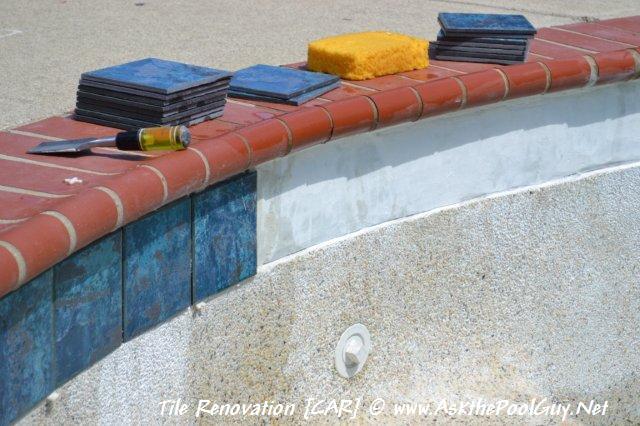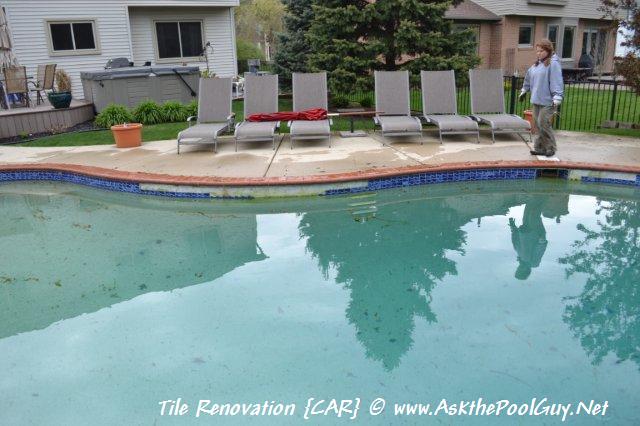Swimming pool renovations can be performed on all types of pools to increase the aesthetic appearance, fix functional issues, and overall add a fresh new look, feel, and function to a pool.
Gunite Swimming Pool Renovations in Michigan
A traditional gunite swimming pool renovation will typically include work on the tile, coping, patio, skimmer, and the pool surface itself such as marcite or pebble.
Tile and Coping Replacement on Gunite Swimming Pools
It is possible to perform a renovation and replace the tile at the waterline of your swimming pool. Keep in mind if you would also like to renovate or replace the coping, this should be done at the same time as the tile since the removal of the coping stones could cause tile to fall off and it is best to plan ahead. The definition of coping is the cap on the edge of a swimming pool or spa, which is mounted on the bond beam.
Tile Replacement on a gunite swimming pool
The function of Swimming Pool Tile
Tile on a swimming pool performs the functional purpose of disguising the scum line or “bathtub ring” that would be visible on the surface of the pool due to the fluctuating water line due to evaporation, bather load, and water level. Many homeowners may wonder if eliminating the tile line would be a better option, especially in climate where freeze/thaw and beam shear may be a concern. The tile is really the best option for the top edge of the pool, as it hides many of the issues that are inherent with gunite. If the tile line were removed or left off of a pool that was built in a typical fashion, the gunite or marcite may develop the cracking and chipping at the frost line, as well a leave that unsightly ring around the pool. There are new methods of building where the interior pool finish is rolled right over the edge of the pool, so there is no need for tile in some cases.
Tile loss due to beam shear
Gunite Swimming Pool Surface Finishes
The pool surface can be refinished with the traditional white marcite, the marcite could be dyed a color, or a pebble or other aggregate finish could be used.
Painted Gunite Swimming Pools
If a gunite swimming pool has been painted, typically the pool will need to be re-painted every 1-2 years. If you haven’t already painted your gunite pool, we recommend that you do not. It’s relatively simple to acid wash a gunite pool surface, whether marcite or pebble, but once you put paint on the surface it is not a great option. The only way to return a painted gunite pool to it’s best condition would be to sand blast the paint off the surface and perform a re-marcite or re-pebble process.
Gunite Swimming Pool Main Drains
When a gunite pool is being re-surfaced, it is also a great time to perform a main drain update. Many older gunite pools are equipped with just one main drain. The code currently requires two dome-shaped drains, spaced at least 5′ apart be installed on new installations. At the least the main drain should be changed to reflect the dome-shape, and wherever possible, updating to two is the best choice.
Gunite Swimming Pool Skimmers
Gunite pools also often experience leaks at the skimmer, and cracking in the skimmer itself. This is due to the shifting of the ground for a variety of reasons, including seasonal freeze/thaws, and overall ground movement. It is very common to see pool putty in a gunite skimmer that helps to patch any leaking areas to try to avoid having to replace the skimmer entirely. A skimmer replacement can happen at any time, and would include cutting the concrete or patio to expose a foot or two of work space surrounding the skimmer. The skimmer is then dug out, removed from the pool deck, and the pool, and a new one installed. There may be some damage to the tile or surface of the gunite pool, no matter how careful the process may be, so some patching and repair work of the marcite, pebble and tile may also need to be done.
Lifespan of Tile, Coping, Marcite and Pebble
Swimming pool tile in even when installed perfectly, can shift and fall off a pool in some cases within a year of being installed. Especially in freeze/thaw climates, even the most meticulous of installations cannot be guaranteed.
The surface of the pool, whether marcite, pebble, or alternative finish should last 10-30+ years. Over time the water chemistry will affect the surface, and can cause etching or pitting in the surface. These are the lines or pock marks that show up in the pool. These happen because when water conditions become aggressive, the water will pull minerals out of the surface of the pool, effectively eroding the surface. The surface may also become rough, either due to the etching or pitting, or in the reverse case, when water deposits minerals to the surface of the pool.
A white marcite surface freshly acid washed
Homeowners often choose to perform gunite pool renovations to address functional issues, though many times it’s purely aesthetic. If your family enjoys a pretty pool more than an older looking or dated pool, then it’s always a great decision to make.


